SAIT is expanding reconciliation efforts on campus and in the community

Indigenizing curriculum and a new student success initiative will support systemic change
As we continue Truth and Reconciliation efforts at SAIT, the Office of Indigenous Engagement has been busy identifying new areas to support our community on and off campus. A commitment to Indigenizing curriculum across SAIT programs and launching a new career navigation initiative are part of our larger initiative to encourage awareness and support Indigenous learners’ success.
Join us in getting to know the people who are bringing this work to life!Dr. Teresa Miles, Indigenous Instructional Designer
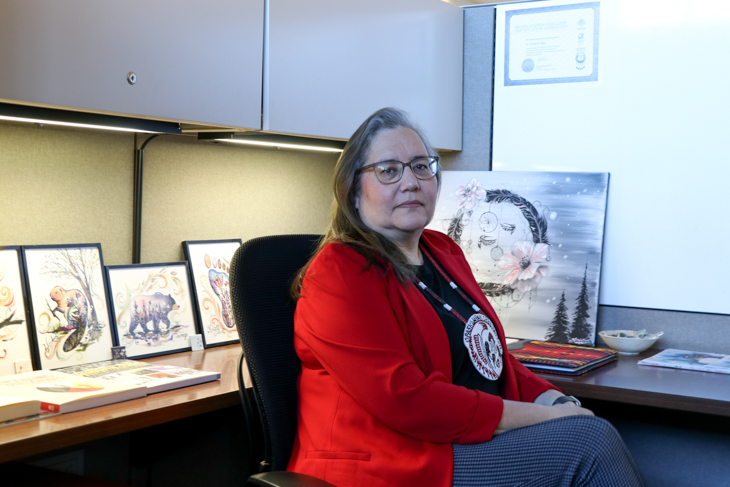
We would be remiss if we didn’t paint a picture of Teresa Miles’ interview. Joining the call from her home office, she’s surrounded by vibrant and colourful art created by Indigenous sisters. Hanging among the paintings are tokens of Miles’ past achievements — a decorated graduation cap, the blanket from an Indigenous graduation ceremony and beaded medallions — and mementos presented to her in thanks for the impact she’s had on others.
Miles is the embodiment of lifelong learning — her own, her children’s and now students’ at SAIT. As a young mother, she homeschooled all four of her kids and quickly learned how to navigate curriculum and Alberta’s education system. When life took Miles in a new direction, she decided to start her journey into post-secondary education, which began with upgrading at Bow Valley College.
With her mind initially set on law school, she completed a Bachelor of Arts in Criminal Justice. As her educational interests developed, Miles enrolled at the University of Calgary to complete a Master of Education, specializing in Leadership for Learning, and a Doctor of Education, specializing in Curriculum in Context. As her education evolved, she knew she wanted her work to be driven by reconciliation and decided to focus her dissertation research on the emotional experience of non-Indigenous educators teaching Indigenous curriculum.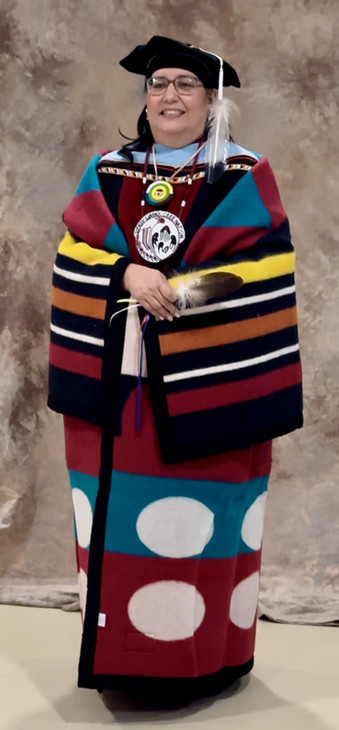
In some ways it feels like the culmination of her lived experiences were preparing Miles for the role of Indigenous Instructional Designer. Without knowing it, she was building a resume tailored for the new role on SAIT’s Indigenous Engagement team.
Initially an instructor in the Indigenous Foundations and Pathways programs, she was asked to also teach an Indigenous Perspectives course within the Early Childhood Education program. The course was rooted in Blackfoot knowledge, and she expressed concern delivering curriculum from a lens of Indigenous heritage and teachings that were not her own.
“I’m Cree and I can’t teach Blackfoot knowledge because I don’t know it. I spoke with the Academic Chair and suggested they either hire a Blackfoot instructor or re-design the curriculum from a more inclusive Indigenous perspective. I said could teach it and re-write the course as I’m going through it. So that’s what I have done.”
This experience further emphasized the importance of her new role and provided important insight to supporting the Indigenization of curriculum across programming at SAIT.
“I went from teaching exclusively Indigenous students to teaching students from a variety of backgrounds about Indigenous topics. It was a really good experience and it’s given me perspective into another way of teaching.”
Indigenizing curriculum across campus sounds like a monumental task but Miles’ approach is focused on varying levels of systemic change. While reviewing courses and creating space to add value through Indigenous outlooks and experiences is one aspect of her work, she is also building relationships with the SAIT community to create awareness for her role as a resource to faculty and staff.
“I’m fascinated by what is going on across campus at SAIT. I’ve met with so many people looking to Indigenize their curriculum and working towards the same goal. But it is also as simple as someone emailing me to confirm they’re using the correct terminology. They are doing the work to educate themselves and want confirmation that they are on the right path.”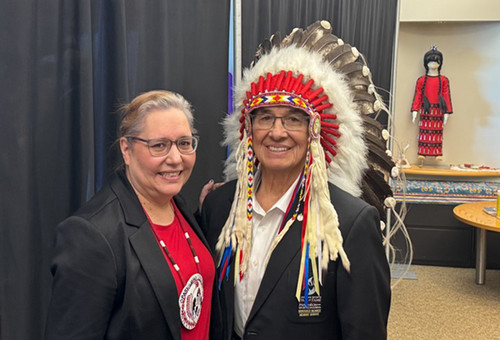
The MacPhail School of Energy is another area Miles sees as an opportunity to weave Indigenous knowledge into programs connected to natural resources and the environment. “Any time you’re talking about the environment and sustainable stewardship practices, it directly relates to Indigenous perspectives on land-based knowledge and education.”
While this new position evolves and finds its place on the Indigenous Engagement team and at SAIT, Miles is motivated by the immense potential the future holds.
“It has been really validating, and I am still learning to recognize the value and expertise I bring to the conversation. My hope is just to contribute to reconciliation and that’s what SAIT is working towards — I am just a piece of it.
“I've always defined reconciliation as a two-way street where Indigenous and non-Indigenous people walk together. No matter where you are on your path, we must be willing to do the work together to make reconciliation a reality.”
Tahner Blackwater, Indigenous Student Success Navigator
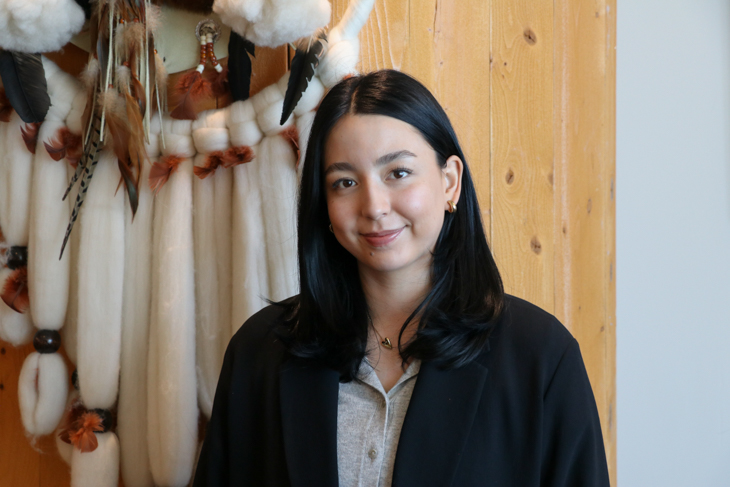
Tahner Blackwater always knew she wanted to do something that would create change. When she saw SAIT was hiring an Indigenous Student Success Navigator, she saw an opportunity to have a lasting impact.
A member of Kainai Nation (Blood Tribe), Blackwater grew up in Lethbridge and Okotoks before moving to Calgary to complete her post-secondary education — she graduated from the University of Calgary with a Bachelor of Arts in Law and Society and a minor in political science.
Joining the Indigenous Engagement team at SAIT has felt like a perfect fit. “I’ve always held a strong sense of purpose and ambition, particularly when it comes to advancing Indigenous empowerment. I am deeply committed to driving meaningful change and contributing to solutions that address Indigenous issues — no matter how big or small. I’m committed to giving back to my community through my work.”
Last year, SAIT partnered with Vancouver Island University to administer an Indigenous Student Success Program and create pathways to success for Indigenous graduates in Alberta. The four-year pilot program provides qualifying graduates with an opportunity to secure meaningful, sustainable employment by matching them with career opportunities. Eight Alberta post-secondary institutions (PSI) are participating in the program.
As the program is being developed, SAIT is prioritizing outreach to businesses with a demonstrated commitment to an Indigenous talent pipeline. By providing a direct route for recent graduates to receive hands-on experience, graduates will build on workplace skills and knowledge and strengthen professional networks.
At university, Blackwater learned about Truth and Reconciliation and the 94 Calls to Action on a deeper level. It spurred her interested in reconciliation through sustainable economic development and drive to see more Indigenous leaders in the workplace.
In this new role as Indigenous Student Success Navigator at SAIT, Blackwater is ready to work with Indigenous graduates to build confidence and offer support as they enter the workforce — to contribute to job retention and long-term success. She’s also focused on building relationships with other PSIs, ideally making the program available across the province.
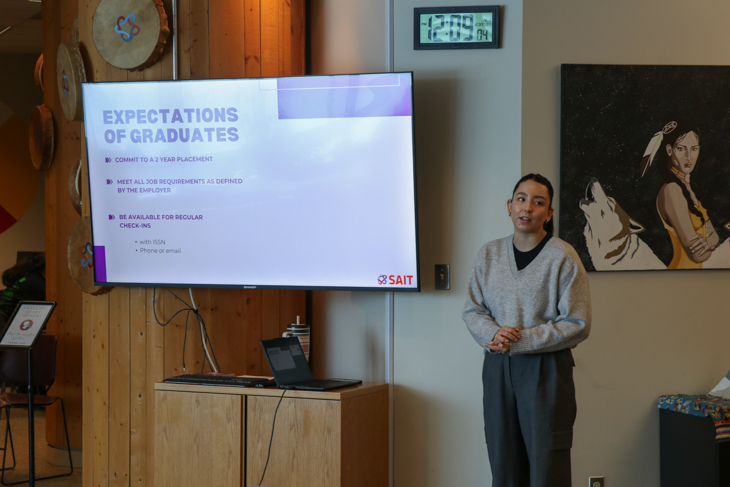
“Being a recent Indigenous graduate myself, I really understand the barriers and societal gaps that can be found between education and employment. I’m working to empower Indigenous graduates by connecting them with sustainable employment opportunities aligned with their individual goals and strengths.”
Before a graduate can be matched with an employment opportunity, a company or organization must have a demonstrated understanding of Indigenous issues and needs a proven commitment to Truth and Reconciliation. An intended outcome is to create more culturally safe environments for Indigenous professionals in the workplace.
With over 60 prospective employment partners, Blackwater is focused on outreach efforts to continue growing the program and finding new companies that are a good fit.
“Corporate partners must demonstrate their commitment to uplifting Indigenous employees and be able to provide a mentor who is Indigenous or holds significant knowledge on Indigenous issues. Do they have or are they working towards a strong Indigenous talent pipeline?”
And her role doesn’t end once a graduate is successfully matched with an employment opportunity.
“I'll also provide dedicated support during and after employment for everyone involved to strengthen their professional network as we build future leaders in the workplace. I’m here to help graduates succeed. I want to know their goals and aspirations and how I can help support their growth.”
Blackwater is where she feels she’s meant to be — building strong foundations with graduates, seeing them flourish and contributing to a growing population of Indigenous leaders.
“I wasn’t initially aware a role like this existed. It is deeply rewarding to support Indigenous graduates and I feel privileged to contribute in this way. This is also a significant opportunity for my own personal and professional growth.
“Education is a fundamental pillar of reconciliation, and I’m supporting Indigenous graduates in a meaningful way. I’m driven by a deep sense of responsibility to honour my ancestors through my work, so that’s what I’m doing — it’s what I’m working towards.”
Oki, Âba wathtech, Danit'ada, Tawnshi, Hello.
SAIT is located on the traditional territories of the Niitsitapi (Blackfoot) and the people of Treaty 7 which includes the Siksika, the Piikani, the Kainai, the Tsuut’ina and the Îyârhe Nakoda of Bearspaw, Chiniki and Goodstoney.
We are situated in an area the Blackfoot tribes traditionally called Moh’kinsstis, where the Bow River meets the Elbow River. We now call it the city of Calgary, which is also home to the Métis Nation of Alberta.